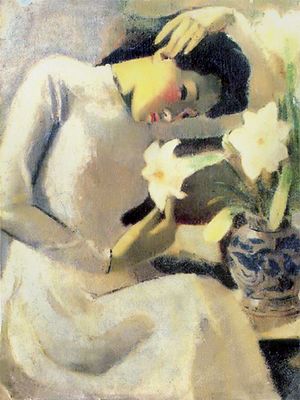Tô Ngọc Vân facts for kids
Quick facts for kids
Tô Ngọc Vân
|
|
|---|---|
 |
|
| Born | 1906 Hưng Yên
|
| Died | 1954 (48 years old) |
| Nationality | |
|
Notable work
|
Younger lady beside tuberose |
| Awards | Ho Chi Minh Prize |
Tô Ngọc Vân (born December 15, 1906, or 1908 – died June 17, 1954) was a famous Vietnamese painter. He was also known as Tô Tử. You can see many of his beautiful paintings at the Vietnam National Museum of Fine Arts.
Tô Ngọc Vân was a teacher who taught art classes during a time of war. He sadly passed away due to injuries he received while working during the Battle of Điện Biên Phủ. In 1996, he was one of the first people to receive the important Ho Chi Minh Prize for his contributions.
Contents
Early Life and Artistic Journey
Tô Ngọc Vân was born on December 15, 1906, in Xuan Cau village, which is in the Van Giang district of Hung Yen province. Some records say he was born in 1908.
Even though his family was not rich, Tô Ngọc Vân loved art very much. He even left high school early to follow his dream of becoming an artist. In 1926, he passed the tough entrance exam for the Vietnam University of Fine Arts. He was part of the very first group of students there and graduated just two years later.
A Teacher and Influencer
Tô Ngọc Vân became a painting teacher at Bưởi school. He also taught as a professor at the École des Beaux-Arts de l’Indochine. Later, he became the principal of the Việt Bắc Art School. He taught many young artists in Vietnam, and his work greatly influenced a whole generation of painters.
Artworks and Other Contributions
Tô Ngọc Vân painted many different places, including cities like Bangkok, Huế, and Phnom Penh. His art often showed the beauty of Vietnam and its people.
Besides painting, he also drew cartoons for magazines like Phong Hóa, Ngày Nay, and Thanh Nghị. These cartoons often showed everyday life and important events happening at the time. He also wrote about art for newspapers, sharing his thoughts and ideas as an art critic.
A Lasting Legacy
Tô Ngọc Vân's work is still remembered and celebrated today. As a special honor, a crater on the planet Mercury was named To Ngoc Van (crater) after him! This shows how important his art and influence were.


